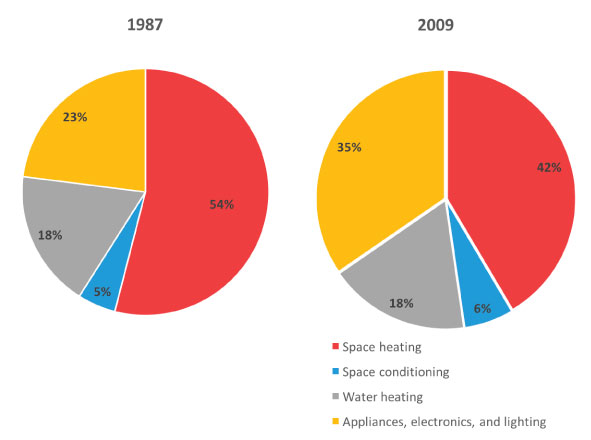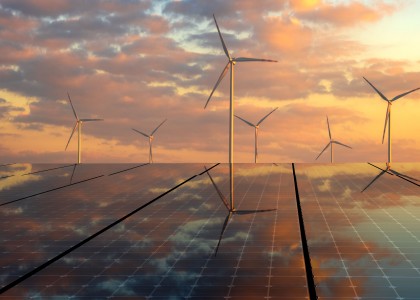Earth Day was first celebrated in 1970, and that got us thinking about how households used energy back then. What did they use it for? Do we follow the same conventional wisdom for saving energy in our homes today, even though there are some obvious differences in the types of devices we use now? We were curious to dig in and see how energy use has changed over the past 35+ years, and how that change shapes our efforts to conserve.
Let’s travel back to the 1980s, when the first comprehensive survey of US residential energy use was published, to get an idea of how the average American household was using energy at the time. Microwaves were just beginning to gain popularity (14% of households had one) and personal computers were so rare that a question about them didn’t even appear on the survey. Ten years later in 1990, almost 80% of households had microwaves and 70% of households had personal computers (EIA 2015). From there the number of electronics and other miscellaneous loads have only continued to grow (AEO 2015).
Meanwhile, heating and air conditioning systems and major appliances are becoming more efficient during this time period, and new homes are being built with more insulation and more efficient windows. Between the late 1980s and late 2000s the share of household energy used to heat and cool a house shifted from a majority of the overall load (61%) to less than half (48%). Over the same time period the share of energy used for appliances, lighting, electronics, and other miscellaneous energy loads swelled from 23% to 35% (EIA 2013, 1987).
During this time, lighting and major appliances on the market were getting more efficient, largely thanks to energy efficiency standards, so why the big increase? You can probably think of more than a few devices that are common in homes today that did not exist in the 1980s. While no single device is a particular energy guzzler, in sum their cumulative impact adds up.
So what can we learn from these statistics to help save energy in our own homes? Now more than ever, we need to address a variety of end uses to help chip away at the cost of our energy bill. While heating and cooling loads are still important to address, especially in hot and cold climates (need insulation and air sealing? Here’s how to get it done right), we need to consider a range of energy end uses. Drawing from ACEEE’s energy efficiency consumer resource, smarterhouse.org, we offer a few recommendations for how you can make smart energy choices in your own home.
- Addressing growing electric use requires a variety of strategies. Smarterhouse.org provides a number of ideas for addressing the energy use of the home electronics you already have, and for making smart decisions when purchasing new ones. There are efficient options for products including TVs, computers, set top boxes, and audio equipment. Look for the ENERGY STAR® rating to get the most efficient model.
- Major appliances like clothes washers, refrigerators, and dishwashers are much more efficient than they were in the 1980s. If you’re still hanging onto an old appliance, it makes financial sense to replace it (and, if it’s the second, spare fridge in the garage, consider whether you really need it—if the extra fridge space is a must, replace it with a high efficiency model). Today’s models are so much more efficient than they were in the 1980s (and even the 1990s) that the return on your investment won’t take long. For example, average energy use for refrigerators decreased by almost 70% between 1980 and 2014. If you replace your 1980s refrigerator with a new ENERGY STAR model you would save about $200 a year. Find buying tips here.
- Saving energy in your home in the most cost-effective way possible requires planning and coordination. Getting ready to do a home improvement or remodel? Need to replace a major appliance? Here’s how you can incorporate energy efficiency into your project to be sure to invest in products and improvements that will save you over their lifetime.
- Unless it’s not working and you’re stuck taking a cold shower, the water heater is not an appliance that people think much about. Instead of waiting for it to break, do some research now to figure out what the most efficient option is for your home. High efficiency electric heat pump water heaters are increasingly common and readily available, and use 50% less energy than a standard electric tank. That amounts to about $200 of energy savings annually, and well over $1000 over the lifetime of the unit. Find heat pump water heaters rated by ENERGY STAR here.
For more recommendations on how you can make the smartest decisions about using energy in your home, visit SmarterHouse. In celebration of Earth Day this year, we encourage you to commit to acting on some of these energy saving recommendations that can both save you money and cut down on energy waste.




